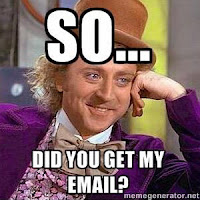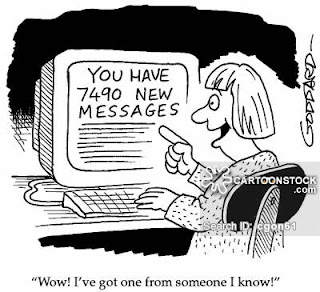 Last week we talked about trigger words and phrases and how the wrong subject line can see your carefully
constructed emails idling in their recipients’ Spam folders, never to be seen.
Knowing which words and phrases are likely to earn you the proverbial red card
is the easiest way to avoid this. However, Spam filters are becoming more and
more sophisticated and there are a number of
Last week we talked about trigger words and phrases and how the wrong subject line can see your carefully
constructed emails idling in their recipients’ Spam folders, never to be seen.
Knowing which words and phrases are likely to earn you the proverbial red card
is the easiest way to avoid this. However, Spam filters are becoming more and
more sophisticated and there are a number of
Not to worry however, as DEC will be running a series of
articles on Spam filters and how to get past them. This is the second of the series, and I'd like to talk a little about why spam filters are important, as well as giving you some examples of behaviour that may cause you to end up on the wrong side of them.
Remember Who the Enemy Is
As a marketer, it’s easy to see spam filters as the enemy and
an obstacle to our own ends. Before you get too annoyed with them however, here
are some things to bear in mind: In
2011, the estimated figure for spam messages was around seven trillion, and conservative
estimates suggest that spam comprises 80-85% of all the email in the world. Spamming
remains economically viable because advertisers have no operating costs beyond
the management of their mailing lists, and the costs, such as lost productivity
and fraud, are borne by the public and by Internet service providers, which
have been forced to add extra capacity to cope with the deluge.
Moreover, spamming really lowers the bar in advertising and
trivialises your efforts to deliver quality, useful content that your audience
will want to read. We have a responsibility as marketers to keep our standards
high and tackle this problem rather than contribute to it. The rewards of
striving to always deliver valuable content are two-fold; we raise the bar for
legitimate advertising and we build a great reputation with our customers so
that they actually read and engage with our emails in future.
“But *my* content is always valuable!”
 I'm not saying that one or two faux pas in your mail-out
puts it into the same category as those dodgy “Meet Singles in Your Area!”
emails we all get from time to time. But even if I'm to judge solely from the
spam folder of my own personal email account, it would appear that an awful lot
of legitimate marketers don’t realise how “spammy” their emails actually are.
The key, really, is to avoid jumping the gun and shouting at your audience. It sounds like a no-brainer, but we are
all guilty of
I'm not saying that one or two faux pas in your mail-out
puts it into the same category as those dodgy “Meet Singles in Your Area!”
emails we all get from time to time. But even if I'm to judge solely from the
spam folder of my own personal email account, it would appear that an awful lot
of legitimate marketers don’t realise how “spammy” their emails actually are.
The key, really, is to avoid jumping the gun and shouting at your audience. It sounds like a no-brainer, but we are
all guilty of
Here are a few classic mistakes marketers make which
inadvertently “spammify” their emails:
1.
USING ALL-CAPS
Inside voices, people! Nobody likes to be shouted at. Using
all caps in your subject line might get people’s attention, but this looks
spammy and can really rub people the wrong way. In fact, a study by
the
Radicati Group found that more than 85% of respondents prefer an all-lowercase
subject line to one in all caps. This might sound like a no-brainer, but when
you consider that 69% of email recipients report email as spam based solely on
the subject line, you'll want to stay away from triggers like this as much as
you can.
2.
Exclamation marks!!!!!
These are another seemingly obvious thing that can make your
subject line or email look unprofessional. It’s a faux pas of writing as well
as marketing to try to make punctuation do the job
that words are supposed to
do. If your words are not enough to get readers excited about our content, it’s
time to get back to the drawing board.
3.
Using video or Flash in emails
Most email providers automatically disable rich media like
Flash or video embeds anyway, so it’s not worth trying. Instead, use an image
of your video player (with a play button) that links to the rich media on a
website page.
4.
Including attachments
If you want to send your recipients something like a PDF or
a Word document, don't attach the file to the email -- otherwise your email
could get blocked by spam filters. Instead, upload the attachment to your
website and link to the file location in your email using an effective call-to-action button. This will minimize the chance
of it being blocked by spam filters and decrease the load time of your email.
That Radicati Group study I mentioned earlier also found
that for 80% of respondents, spelling and grammatical errors are the worst
offence possible. But in addition to being unprofessional, these errors are
also a spam trigger. Everyone slips up from time to time, so always run a
spell-check as well as proof-reading your emails yourself.
6.
Too many images
Emails jam-packed with images, or which contain excessively
large images, tend to end up in the spam folder as filters can’t read images.
This happens especially if the email is heavy on images but contains little
text.
7.
A few other things worth mentioning:
·
URL shorteners are often used within emails to
hide malware so are a big red flag to spam filters.
·
Designing a HTML email in Microsoft Word is
another mistake; the code is sloppy and scores highly within spam filters.
·
Sending tests multiple times to recipients
within a company can also get you into trouble because of firewall issues.
8.
…And of course, avoid trigger words and phrases.
See last week’s article for
information on how trigger words work and our list of top offenders.
Adapted from this Hubspot article.




